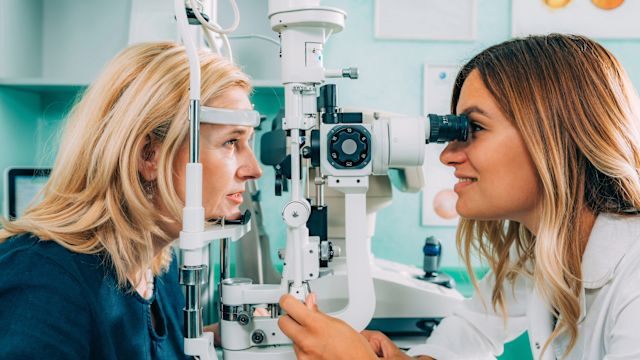Updated on September 26, 2024
If you’re living with age-related macular degeneration (AMD), regular appointments with your eye care provider are essential to protecting your vision and keeping your eyes healthy.
AMD occurs when the cells of the macula deteriorate. The macula is the part of the eye that enables central vision—the ability to focus on objects in front of the eye and see details. In the early stages of AMD, this may not cause any symptoms. As AMD progresses, it can cause central vision loss that makes it difficult to perform everyday tasks like driving and reading.
Monitoring and treatment
Follow-up visits are an important part of AMD treatment. Because AMD is a progressive condition, your eye care provider will need to monitor for any changes. If you have an advanced form of AMD, you will need follow-up visits to receive treatment.
Monitoring AMD progression
While you should contact your eye care provider any time you notice a change in your vision, AMD can cause damage even before your vision is affected. When you visit your provider, they can examine the macula to determine if AMD has progressed. Follow your eye care provider’s advice on how often you need follow-up exams.
Staying on top of treatment
If you have an advanced form of AMD—wet AMD or geographic atrophy—your healthcare provider may prescribe therapies to slow the progression of the disease. Wet AMD is treated with anti–vascular endothelial growth factor (anti-VEGF) therapy. Geographic atrophy is treated with medications called complement inhibitors. Both types of therapies are delivered through injections into the affected eyes.
These injections are typically painless and require only a short visit to an eye care provider’s office, but injections must be given every few weeks or every few months (depending on the medication being used).
What to discuss with your eye care provider
Consider discussing these topics at every visit with your eye care provider:
- Any new symptoms. Even if your vision has been stable for a while, it’s always good to be on alert for any new symptoms. Tell your eye care provider if you have trouble seeing things that are straight ahead, or if you’re noticing that the lines on an Amsler grid look curved or blocked out when you monitor your vision at home.
- Improvement in symptoms. It’s also good to tell your eye care provider if you’ve noticed any improvement in your previous symptoms. This would mean that things look clearer when you stare straight ahead, and your vision isn’t clouded by gray, white, or black regions on an Amsler grid, if that was an issue before.
- If AMD affects your daily activities. Your eye care provider will want to know how AMD is affecting your everyday life. Tell them if AMD is getting in the way of reading, driving, or any other activities. Ask what you can do to adapt.
It’s common to have other questions about AMD. You might want to ask:
- What steps can you take to slow the progression of AMD and protect your vision?
- What can you expect if the condition worsens or progresses?
- What are your treatment options?
- What devices and other resources can help you live with vision loss?
Preparing for your appointments can help you get the most from your time with your eye care provider. Keeping up with follow-up appointments can help you protect your vision and get the most from treatment.





